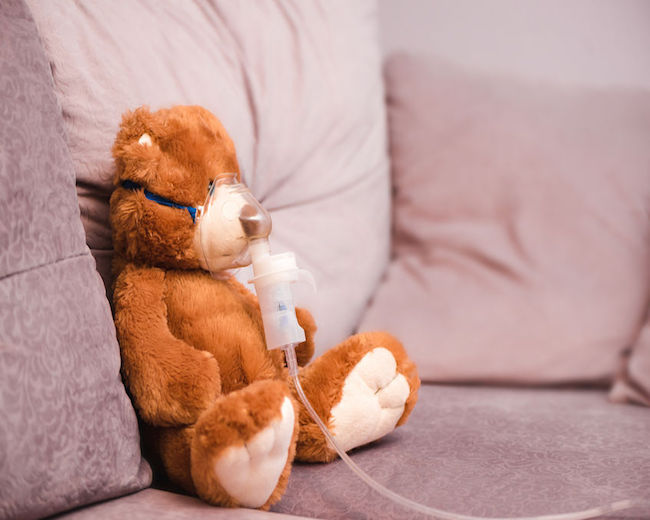Signs your toddler may have asthma - and how to treat it
Asthma, a chronic disease that affects the lungs and airways, can make it difficult for your toddler to breathe. And with childhood asthma on the rise, more and more families are facing this challenge.
According to the 2018 Global Asthma Report, asthma is the most common chronic illness in South African children and has shown an increasing prevalence in both urban and rural areas. Studies show thar second-hand smoke exposure and living in highly populated areas can exacerbate asthma in young children.
Asthma explained
“Asthma is a condition in which the lower airways (bronchi) are hyperreactive, so they constrict more easily than they should in response to stimuli such as exercise, illness, emotions such as laughter or anxiety, or allergens such as house dust mites, pollens, animal dander or mould,” explains paediatrician and allergy specialist, professor Claudia Gray from the Kidsallergy Centre and Red Cross Children’s Hospital in Cape Town.
Professor Gray goes on to explain that the “hyperreactive chest” is due to inflammation and swelling of the lining of the airways, and thickened muscles around the airways which tighten intermittently. This can then lead to coughing, wheezing (a whistling sound during exhalation because of the narrowed airways) and breathing difficulties.
Causes of asthma
Although many babies and young children suffer from bouts of wheezy illnesses due to viruses, only a few go on to develop full-blown asthma.
This is because the development of asthma depends on many factors, such as:
• Genetic (hereditary) factors
• Several environmental factors, such as respiratory illnesses and/or pollution
• The local microbiome in the airway
“The local microbiome refers to the set of ‘bugs’ living naturally in the airway, which need to be of a healthy variety in order for the immune system within the airways to function well,” explains professor Gray.
Signs of asthma
There are several clues which suggest that a wheezy illness may be developing into asthma:
• Your child experiences wheezy episodes or a cough outside of times when they’re ill, such as when they’re running around a lot, crying or laughing, or exposed to cold air. A cough in the early hours of the morning is also suggestive of a reactive airway, says professor Gray.
• They have signs of other allergies, especially eczema and nasal allergies.
• They’re sensitive to environmental allergens such as house dust mite, grass pollens, mould or animal dander.
• They have a family history of allergies, especially asthma.
Your child may also experience:
• Shortness of breath
• Fast or laboured breathing
• A tight chest
“In children with recurrent wheezy episodes and one or more of the above risk factors, no matter how young, a diagnosis of asthma should be considered,” adds professor Gray.
When should you see a doctor?
According to the Nemours Foundation, if your child has constant wheezing or a lasting cough that doesn’t respond to “quick relief” medication, it’s best to see the doctor.
These symptoms also indicate that urgent medical help is needed:
• Laboured breathing with retractions – where the areas below the ribs, between the ribs and in the neck pull in during each inhalation.
• Changes in your child’s colour like blue or grey lips and fingernails.
• Signs of an asthma attack including shortness of breath, a tight chest, fainting, a fast heartbeat, being too breathless to speak.
Can asthma be prevented?
Because asthma is a complex disease and is often hereditary, it’s not always possible to prevent it in young children.
However, factors that may help with prevention include:
• Early diagnosis and good management of other allergic disorders such as eczema and nasal allergies
• Avoiding contact with tobacco smoke, during pregnancy and in the childhood years.
• Eating a diverse, healthy diet.
• Good management of respiratory viruses and infections to prevent longstanding damage to the lung tissue.
• Preventing nutritional deficiencies, such as a vitamin D deficiency.
“Scientists are looking into supplements such as fatty acids, vitamin D and pre- and probiotics for allergy prevention but there’s currently no definite evidence for them,” adds professor Gray.
Will my child outgrow asthma?
Professor Gray says that the course of asthma varies from person to person. “Some children do outgrow their asthma during childhood; and some children continue with asthma symptoms into adulthood. Sometimes the severity of the asthma changes over time from more severe to milder, or vice versa. It’s important for children with asthma to undergo regular reviews by their doctors to adjust treatment and determine whether the asthma has been outgrown or not over the years.”
How should I treat my child’s asthma?
Once asthma is established, excellent treatment of both nasal allergies and asthma with relevant sprays and asthma pumps/medications is essential for good control and to help prevent further asthma attacks. The key to keeping asthma under control is to use the right medications with an anti-inflammatory effect, rather than just “as needed” treatment with a muscle relaxant pump, explains professor Gray.
The best all round anti-inflammatory medication for asthma is a steroid-based inhaler. The fine steroid particles can be inhaled via a variety of devices, which need to be chosen specifically to meet the needs of each individual patient.
“Inhaled steroids are excellent anti-inflammatories and should ideally be used daily, as advised by your child’s doctor, to reduce swelling and over-activity of the airways. They are incredibly safe medications with extremely little absorption from the chest into the body and have a far lower side-effect profile than most medications taken by mouth. Regular inhaled steroid-based asthma pumps are key to good asthma control, to reduce flare-ups/asthma attacks and to reduce long term damage to the airways,” says professor Gray.
IMAGE CREDIT: 123rf.com



